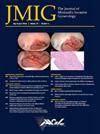Multiple Hysteroscopic Surgery Combined With Fenestration for the Treatment of Diffuse Uterine Leiomyomatosis
IF 3.5
2区 医学
Q1 OBSTETRICS & GYNECOLOGY
引用次数: 0
Abstract
Objective
Diffuse uterine leiomyomatosis (DUL) is a unique growth pattern of fibroids that can lead to infertility. Due to numerous of myomas, a large amount of dilatant fluid as well as longer time are needed following traditional hysteroscopic myomectomy, and the absorption of irrigating fluids, combined with the pressure from uterine distension, can lead to fluid overload and/or dilutional hyponatremia, resulting in transurethral resection of the prostate (TURP) syndrome. In this study, we proposed a recommended technique for treating DUL to prevent above mentioned complications.
Setting
Shengjing Hospital of China Medical University.
Participants
A 37-year-old young woman was diagnosed with DUL. She presented with menorrhagia (a hemoglobin level of 80 g/L), along with symptoms of dizziness and fatigue.
Interventions
The patient underwent two hysteroscopic procedures to fully resect the fibroids. In the first surgery, some of the fibroids were excised using a combination of hysteroscopic fenestration. During the surgery, hysteroscopic fenestration began with an incision made on the endometrium covering each submucous fibroid using a needle-type electrode. The subsequent myomectomy was then performed with a loop-type electrode solely on the fibroid body. This surgery was finished and 8000 ml of 5% glucose uterine distention solution (the deficit was less than 1000 ml) was used. A second hysteroscopic procedure was then performed to evaluate and address any intrauterine adhesions and to remove the remaining fibroids.
Conclusion
For the patient who underwent two hysteroscopic surgeries combined with fenestration, no case of TURP syndrome were observed during or after the procedures. Her menstruation returned to normal, and no intrauterine adhesions developed postsurgery. The patient achieved pregnancy and delivered at full term, resulting in a favorable reproductive outcome. Combining multiple hysteroscopic surgeries with fenestration, proved effective and feasible for DUL patients seeking to preserve fertility, aiming to reduce the risk of TURP syndrome.
多次宫腔镜手术联合开窗治疗弥漫性子宫平滑肌瘤病。
目的:弥漫性子宫平滑肌瘤病(DUL)是一种独特的肌瘤生长模式,可导致不孕。由于子宫肌瘤数量众多,传统宫腔镜子宫肌瘤切除术需要大量的扩张液和较长的时间,冲洗液的吸收加上子宫膨胀的压力,可导致液体超载和/或稀释性低钠血症,从而导致经尿道前列腺切除术(TURP)综合征。在本研究中,我们提出了一种治疗DUL以预防上述并发症的推荐技术。单位:中国医科大学附属盛京医院。参与者:一位37岁的年轻女性被诊断为DUL。她表现为月经过多(血红蛋白水平为80 g/L),并伴有头晕和疲劳症状。干预措施:患者接受了两次宫腔镜手术以完全切除肌瘤。在第一次手术中,使用宫腔镜开窗术切除了一些肌瘤。在手术中,宫腔镜开窗开始,使用针型电极在覆盖每个粘膜下肌瘤的子宫内膜上切开。随后的子宫肌瘤切除术仅在肌瘤体上用环形电极进行。手术结束后,使用5%葡萄糖子宫扩张液8000ml(赤字小于1000ml)。然后进行第二次宫腔镜手术,以评估和解决任何宫内粘连,并去除剩余的肌瘤。结论:两次宫腔镜联合开窗术患者术中及术后均无TURP综合征发生。术后月经恢复正常,未出现宫腔粘连。患者成功怀孕并足月分娩,生育结果良好。多次宫腔镜手术联合开窗,对于寻求保留生育能力的DUL患者是有效可行的,旨在降低TURP综合征的风险。
本文章由计算机程序翻译,如有差异,请以英文原文为准。
求助全文
约1分钟内获得全文
求助全文
来源期刊
CiteScore
5.00
自引率
7.30%
发文量
272
审稿时长
37 days
期刊介绍:
The Journal of Minimally Invasive Gynecology, formerly titled The Journal of the American Association of Gynecologic Laparoscopists, is an international clinical forum for the exchange and dissemination of ideas, findings and techniques relevant to gynecologic endoscopy and other minimally invasive procedures. The Journal, which presents research, clinical opinions and case reports from the brightest minds in gynecologic surgery, is an authoritative source informing practicing physicians of the latest, cutting-edge developments occurring in this emerging field.

 求助内容:
求助内容: 应助结果提醒方式:
应助结果提醒方式:


